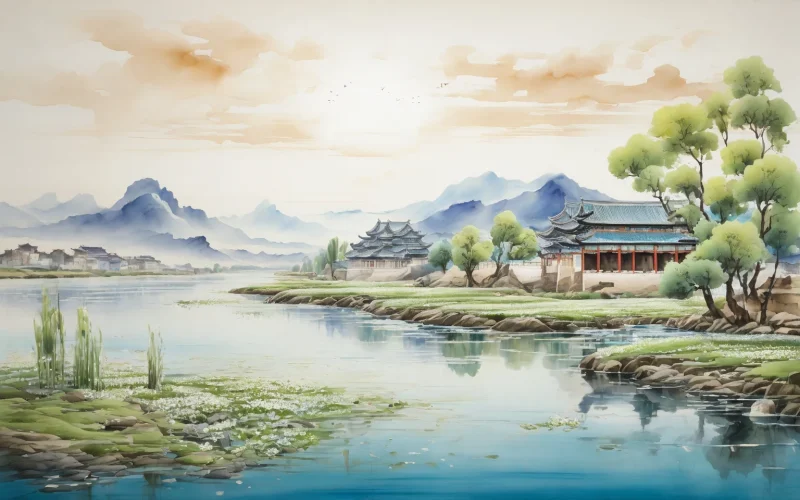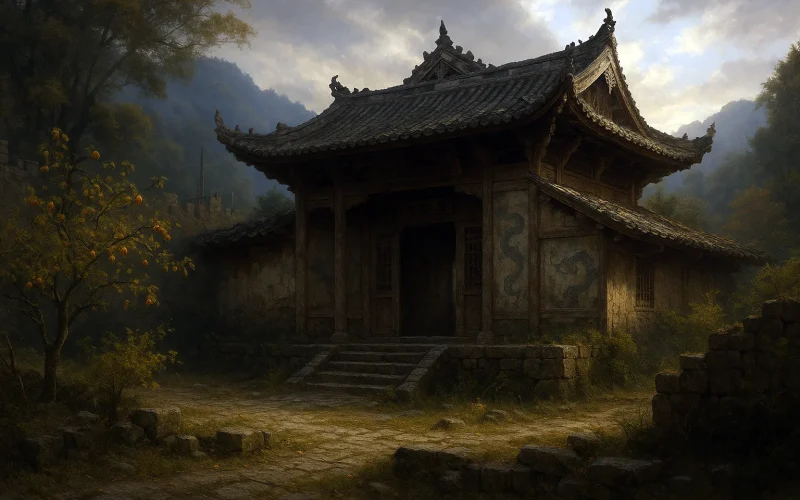The River Bian flows eastward, overwhelmed with spring;
To dust have gone ruined palaces and their king.
Don't gaze afar from the long bank of willow trees!
The willow down will grieve your heart when blows the breeze.
Original Poem:
「汴河曲」
李益
汴水东流无限春,隋家宫阙已成尘。
行人莫上长堤望,风起杨花愁杀人。
Interpretation:
Li Yi composed this poem during the mid-Tang Dynasty while serving as a Registrar in Zheng County. Witnessing societal corruption and the suffering of the people, he expressed his sentiments through the scenery of the Bian River. The poem laments the rise and fall of the Sui Dynasty, using historical events as an allegory to reflect on the current political situation. The Bian River and its surrounding landscapes, including the remnants of the Sui dike and palaces, serve as witnesses to history’s vicissitudes, inspiring the poet's profound reflections.
First Couplet: “汴水东流无限春,隋家宫阙已成尘。”
(The Bian River flows endlessly eastward, carrying boundless spring; the grand palaces of the Sui Dynasty have long turned to dust.)
The poem opens with a reflection evoked by the spring scenery of the Bian River. The river’s eternal flow symbolizes the permanence of nature, while the vanished Sui palaces highlight the impermanence of human affairs. By contrasting nature’s continuity with the transient glories of history, the poet intensifies the sense of loss over the fleetingness of past grandeur.
Second Couplet: “行人莫上长堤望,风起杨花愁杀人。”
(Passersby, refrain from climbing the long dike to gaze afar; the spring wind stirs willow catkins, stirring profound sorrow.)
Continuing with the imagery of the Sui dike and willows, the poet expresses a melancholic nostalgia. The fluttering willow catkins, a beautiful aspect of spring, become symbols of the vanished splendor of the Sui Dynasty, evoking a deep sigh over history’s rise and fall. The wordplay on "杨" (willow), which shares a phonetic similarity with "炀" (Emperor Yang of Sui), adds depth and layers of association.
Writing Characteristics:
- Contrast between past and present, highlighting transformation: The eternal flow of the Bian River sharply contrasts with the decay of the Sui palaces, emphasizing the permanence of nature and the cruelty of historical change.
- Emotional expression through imagery: The poem integrates the sorrow of reflecting on history with the depiction of natural scenes, blending emotion with landscape in a subtle and profound way.
- Double-layered symbolism: Willow catkins are not only symbols of spring but also metaphors for the Sui Dynasty’s fleeting prosperity and decline, enriching the poem’s thematic depth.
- Concise language, profound emotion: In just a few lines, the poem portrays vivid spring imagery while conveying far-reaching reflections on history, leaving a lingering emotional resonance.
Overall Analysis:
The poem centers on the Bian River and the Sui dike. It begins with the spring scenery and gradually transitions to a lament for the rise and fall of history. The river’s continuous flow symbolizes the passage of time, while the dilapidation of the Sui palaces reflects the vanity of past extravagance. The poet uses willow catkins and the spring breeze to illustrate both the present landscape and the unpredictable nature of historical change. Through contrasts between past and present and rich symbolism, the poem creates a vivid sense of nostalgia for the past, interwoven with subtle concerns about the societal issues of the Tang Dynasty.
Lessons:
Using the Bian River as a metaphor, the poet reflects on the lessons of the Sui Dynasty’s rise and fall, expressing concern for the suffering of the people and the cyclical nature of societal prosperity and decline. The poem serves as a reminder that while nature may endure, human endeavors are impermanent, urging vigilance to avoid repeating the mistakes of history. This intertwining of historical perspective and contemporary concerns lends the poem profound moral and reflective significance.
Poem translator:
Xu Yuan-chong (许渊冲)
About the poet:

Li Yi (李益), 748-829 AD, a native of Wuwei in Gansu Province, was one of the “Ten Scholarly Men of the Dali Dynasty”, and is best known for his works on the border and the Plateau, especially for his seven-character stanzas. His poems had a harmonious rhythm and were sung by musicians at that time.












